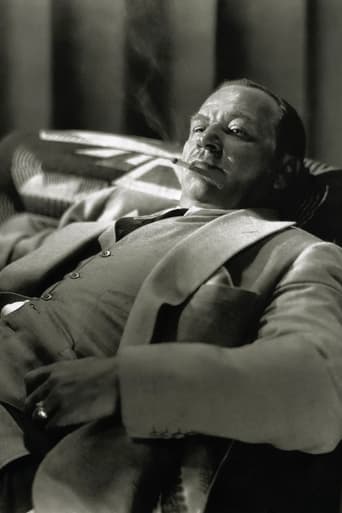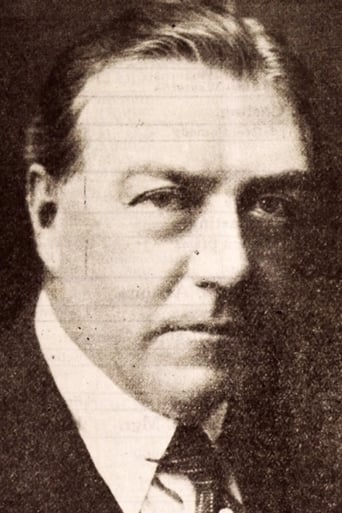Karry
Best movie of this year hands down!
BootDigest
Such a frustrating disappointment
Pluskylang
Great Film overall
Guillelmina
The film's masterful storytelling did its job. The message was clear. No need to overdo.
MissSimonetta
I knew this film had a reputation as a brutal shocker, but I was stunned by how nasty the violence is in Behind the Door (1919)! Far superior to most WWI-thrillers of the period, which were more interested in conveying propaganda than telling a story, Behind the Door is best described as a revenge tragedy.We see no blood or guts spilled, nor do we see every detail of the awful fate of Oscar Kruger's beloved wife Alice, but what we do see is more than enough to disgust. And the way Oscar takes his revenge will have you thinking of the ending of The Black Cat (1934), only in this film, the vengeance is better presented, with far greater horror and pathos, in my opinion-- and I say this as a major fan of The Black Cat.The best part of the movie is the character of Oscar, brought to life by Hobart Boswarth. While he goes a little overboard at times, he sells the character's arc so well. Oscar starts out as this sweet, loving man who, by greater degrees as the movie progresses, is forced into savagery and violence by the intolerant small-town hotheads who view his German ancestry as akin to treason and by the German U-boat crew who brutalize his wife and leave him for dead.The cinematography is stunning, even gothic at times without steeping too far into expressionism.Not to be missed if you love silent films! Heck, not to be missed if you're still under the delusion that the silent era was some kind of age of innocence.
Superhanz
One cannot say there weren't any flaws in either the plot or production - among them, the blatant fact the Bosworth is way too old for his leading role, to be too convincing (he was in between 51 and 52, when this was shot!) - the first time you realize how wrinkly both his face and hands are, I'm sure you'll agree with me! Not that being old is a fault on its own right, it's just that we end up feeling the rather heroic role cries out for a younger thespian, no doubt about it.Also, as I seasoned photographer, I feel the "restored" print (a restoration apparently endorsed by The Library of Congress) could have been, well, more properly restored: on some scenes where the celluloid stuck for many consecutive frames and decay is quite obvious, I feel they missed on the opportunity to simply pick the best frames where some still scenery was not affected by it and simply clone it, just like we photographers do to photographs where there are good and bad ones in a series! When I have the time, I'm going to open some of these frames on Photoshop and intend to prove this theory of mine! But back to the film itself, I found it a touch of genius of how, only in the end we come across the reason for the title (I was starting to wonder if it would ever show up) - very clever indeed - and scary too! Hence my dutifully adding "Thriller" to its genre which, by the time I wrote this, was absent from this IMDb entry.
briantaves
Submarines became a theme in several of producer Thomas Ince's films related to World War I, as I outline in my Ince biography. Some of the motifs of Ince's False Faces and Civilization reappeared shortly; in Moving Picture World, Ince announced that he had "launched Hobart Bosworth in a specially prepared version of Gouverneur Morris' Behind the Door. In this production I have used the sea and submarines in a series of startling pictures which, I believe, will prove one of the screen sensations of the year." $10,000 was paid for the rights to the story. Morris, a prominent author, was an admirer of Ince who visited him at the studio on several occasions.Released at the end of 1919, Behind the Door looked back at the Great War from the perspective of several years in the future, 1925, in depicting atrocities. Captain Oscar Klug (Bosworth) returns home to his Maine town, "alone, forlorn and forgotten." There he finds the dilapidated remnants of his taxidermy shop, where he once loved Alice Morse; "His was not the adoration of a Romantic Youth but the Love of a Man." As noted by an analysis of the film for screen writing purposes in the contemporary Photoplay Plot Encyclopedia, "the central character is made wholly sympathetic throughout the story." Klug is kindly, and overcomes the townspeople's resentment of Germans when war is declared; his family has lived and fought in America for a hundred years. Yet Klug, the German-American, will also become a victim of the beastly Hun of wartime propaganda. Behind the Door simultaneously denounces prejudice while offering a story to fuel the very same hatreds. Klug becomes captain of a ship on which Alice stows away to be with him, but her gesture becomes disastrous when the ship is sunk by a U-boat. Alone, dying in a small boat, Klug and Alice find themselves apparently rescued by a submarine, but it is in fact the same U-boat. The captain, Lieutenant Brandt, played by Wallace Beery, takes Alice on board but leaves Klug to drown. Alice refuses Brandt's overtures, and he turns her over to his savage crew. Somehow Klug survives, vowing vengeance, and Brandt becomes his prisoner. Brandt boasts of what was done to Alice, and how, when his men were done with her, she was shot out through the torpedo tube (the only portion of her treatment not shown). Klug carries out his oath, to skin his adversary alive, but Brandt dies before the torture can be completed. Klug realizes Alice cannot be brought back, and at the close their spirits are united.Director Irvin Willat, having rejoined the studio after wartime service, described the production. "I read the script, and I didn't like it—so I wrote a prologue and an epilogue—mainly to lengthen the story—and it's the only picture I ever made what you might call 'off the cuff.' But Gouverneur Morris had so carefully written—so beautifully written the story, that I was able to work directly from the magazine story more or less—and we made the picture. By adding the prologue and epilogue, I didn't have to drag out the story—I could make it as he had written it—short and effective." Behind the Door is an example of Ince's belief that an unhappy ending is acceptable to the audience if it is the logical conclusion of the story or imparts a lesson. Critics labeled the movie as having an Edgar Allan Poe-like plot, and Photoplay commented, "it took courage to make such a picture as this, for it is a 'he-picture,' no pap for puking infants." Behind the Door cost $84,660 to produce, and grossed $289,039.
BillBarber04
Saw what may be the last exhibition of this film last Saturday (5-8-04) in Rome, NY. Film has been pieced together from several sources. Quality varies from excellent to barely discernible images, with a few scenes entirely missing (Library of Congress Reconstruction).I was amazed at the intensity of this story. It was very obviously influenced by World War I, the German Submariners are shown to be absolute amoral barbarians, but the film is amazing in its craft and impact.The print which we saw is said to be the only one outside of Russia (see below), and its condition is such that Library of Congress has pulled it from exhibition. The Rome, NY showing was the last booked.
I understand that a negative was made from this print, however there are no prints available at the present time.Another complete print of the film is said to exist in Russia, with Russian titles, but no more information was given.I was amazed at how rapidly the story moved. 70 minutes felt like 45!If you have a chance to see this film, DO! You won't forget it.




